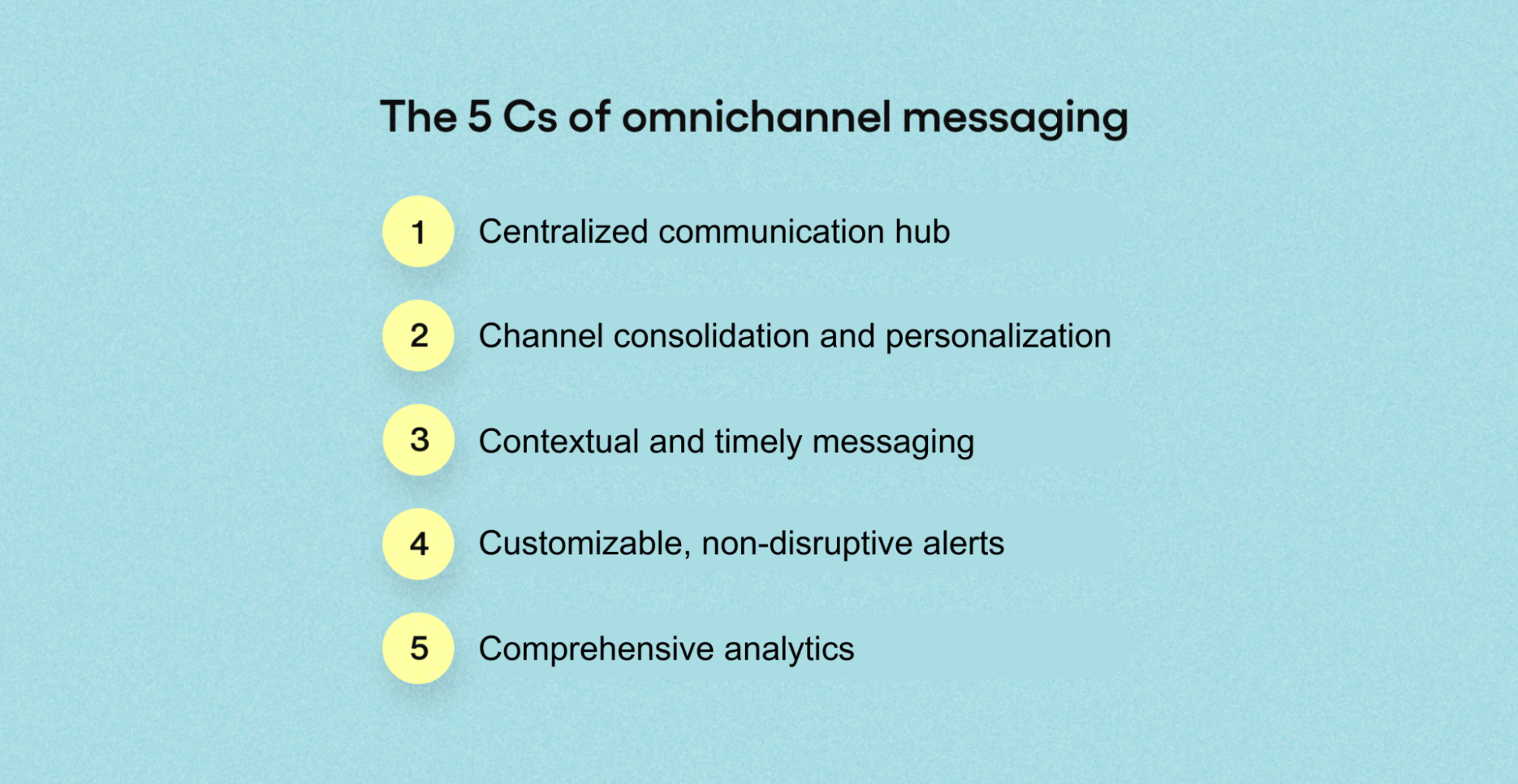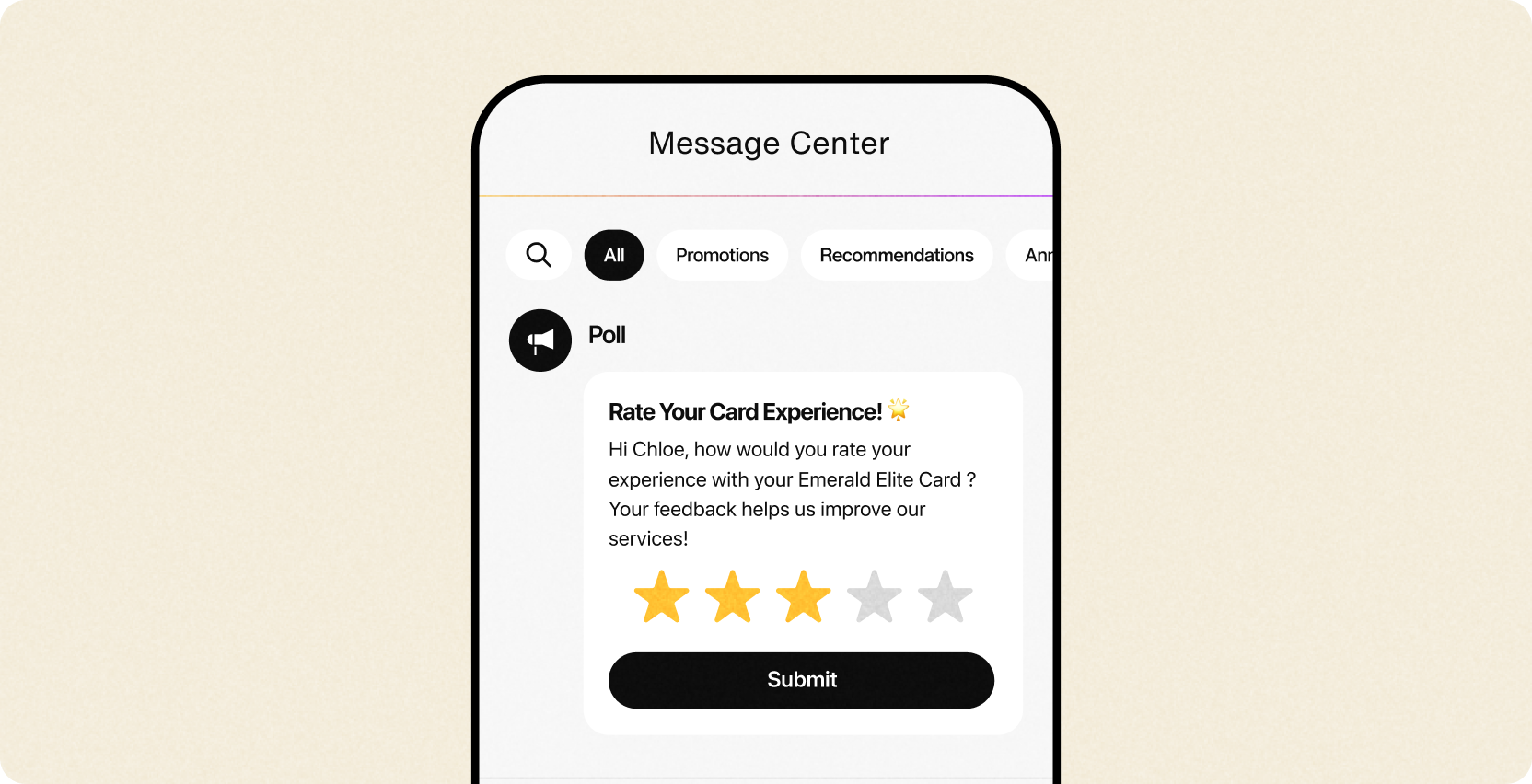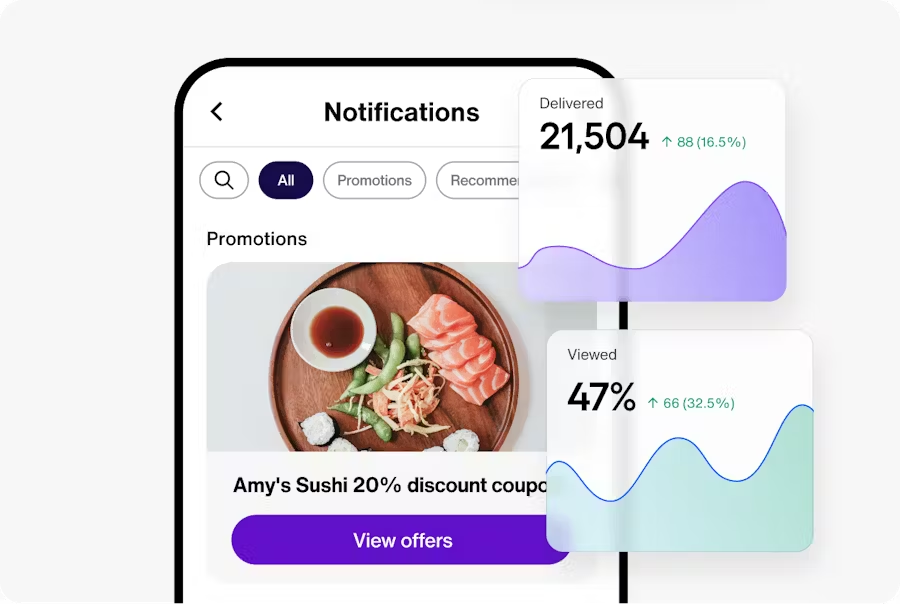The 5 Cs of omnichannel messaging: Solving fragmented communication with an omnichannel messaging strategy

Unified omnichannel messaging for on-demand platforms
Platforms that rely on gig workers to fulfill orders, take on temporary jobs, or provide customer services, face unique challenges in keeping their workforce informed and engaged. After all, every piece of business messaging or communication (such as a push notification, in-app message, WhatsApp message, or SMS), about a product update or a process change can impact a worker’s ability to do their job effectively.
Many on-demand platforms are plagued by a common problem: fragmented communication channels. Cognitive overload, inefficient message tracking, and a lack of relevance are all challenges that stem from fragmented communication. The result is a chaotic and inconsistent experience for gig workers who are left to figure out where crucial information is located, often leading to confusion, missed updates, and lost productivity.
How can this problem be solved? With the 5 Cs of omnichannel messaging. What does this mean? Let’s take a look.
The 5 Cs of omnichannel messaging
To solve the problems of the gig economy, on-demand platforms need more than just a communication tool; they need an omnichannel messaging solution that integrates seamlessly with their platform’s workflow and provides workers with clear, concise, and timely information.
Here are the key capabilities that omnichannel messaging provides to solve the problem of fragmented communication.

Centralized communication hub: Gig workers need a single, unified place within their platform to access all critical communications. Whether it’s a weather alert, a new app feature, or a change of delivery schedule, they should be able to easily retrieve information without needing to remember which channel it came through.
Channel consolidation and personalization: Instead of sending a flood of messages across many channels, platforms need to send fewer messages to targeted recipients. Businesses can do this by understanding which channels are more efficient and using the others only as a fallback.
Contextual and timely messaging: Communications should be delivered in a way that aligns with the worker’s context and needs. For example, a notification about a change in a restaurant pickup should arrive in the app in an alert section as the gig worker takes on the job, not during off-hours by SMS when they’re not engaged with the platform.
Customizable, non-disruptive alerts: While urgent alerts need to stand out, they shouldn’t disrupt the worker’s flow. This is a fine balance to achieve. Notifications should be customizable to fit the design of the app and be delivered in a way that doesn’t interfere with the user experience, particularly during critical tasks like completing an order for an on-demand service.
Comprehensive analytics: Platforms need robust analytics to track the effectiveness of their communications. This includes insights into which messages were opened, read, and acted upon, as well as a clear view of the communication history at the individual level.

How to build the perfect mix of mobile customer communication channels
What does an omnichannel messaging strategy look like?

In the on-demand economy, in which immediacy and seamless experiences drive consumer expectations, an omnichannel messaging strategy across push notifications, in-app messages, WhatsApp messages, and SMS is essential for businesses to stay competitive.
Here's a clear breakdown of what an omnichannel messaging strategy looks like and the steps to implement it.
1. Understand your customers’ journey
Begin by mapping out your customers' interactions with your business. Identify:
Touchpoints: Where do customers interact with your brand (e.g., website, mobile app, social media)?
Pain points: Where are customers experiencing friction or drop-offs?
Behavior patterns: How do customers transition between channels, and what triggers their movement?
A thorough understanding of the customer journey helps you align your messaging strategy with customer expectations.
2. Select & prioritize communication channels
Not all channels are equal for every business. Assess which platforms your target audience frequents. Younger audiences may favor messaging apps like WhatsApp, Instagram, or TikTok, while professional audiences might prefer LinkedIn or email.
You may want to use in-app notifications to offer a native, branded experience to users. Consider sending push notifications to deliver immediate value and to gently nudge users back into your app. Enhancing communication with a WhatsApp API can help your brand reach audiences where WhatsApp is extremely popular, such as in India or Brazil. SMS can be expensive, but is an excellent fallback.
Remember to evaluate the role of tech like AI chatbots so that you can increase the role of automation, marketing, sales, and support to ensure that human staff is freed up to do more strategic work.

How to build the perfect mix of mobile customer communication channels
3. Develop unified messaging templates for omnichannel communication
To maintain consistency:
Craft message templates tailored for each channel, ensuring they reflect your brand voice. Channel-specific content is important because it can enhance user engagement.
Adapt templates for different use cases (e.g., order confirmations, promotional offers, service updates).
Build workflows that dictate how and when messages should be sent to maintain relevance.
4. Leverage automation with AI-powered personalization
Schedule and automate routine tasks like:
Sending order confirmations, reminders, or delivery updates via SMS or push notifications.
Using chatbots to handle FAQs or initial queries.
Pair automation with AI to analyze customer behavior and deliver personalized recommendations, such as tailored product suggestions or relevant, timely support.
5. Ensure real-time responsiveness
The on-demand economy thrives on immediacy. To meet user expectations and streamline messaging:
Implement live support chat or AI tools to offer near-instant responses.
Provide self-service options for quick resolutions, such as help centers or interactive FAQs.
Set clear SLAs (Service Level Agreements) for response times, particularly on high-priority channels that your business’s gig workers like to use.
6. Incorporate feedback loops

Continuously gather customer feedback through post-interaction surveys (e.g., "How was your experience with our support team?"), Net Promoter Scores (NPS) to measure loyalty and satisfaction, or even social listening tools to monitor customer sentiment in real-time. Consider implementing in-app feedback to bridge the gap between your app and its users, fostering a culture of continuous improvement and creating an experience that truly delivers on gig economy workers’ expectations of streamlined omnichannel messaging.
7. Monitor, measure, and optimize your omnichannel communication strategy
Track KPIs to evaluate the effectiveness of your messaging strategy. Key metrics include:
Engagement: Click-through rates, open rates, and response times.
Retention: Repeat customer interactions or loyalty program sign-ups.
Resolution times: How quickly issues are addressed across channels.
Regularly review these metrics to identify trends, improve workflows, and address gaps.
Consider testing your messaging strategy before rolling it out across all channels. To do this, Start with a pilot program on high-impact channels. Then gather insights, refine processes, and address scalability challenges. Once the system is optimized, scale it to cover your entire customer base.

How to build the perfect mix of mobile customer communication channels
Why omnichannel messaging is important for gig economy workers
In a nutshell, omnichannel messaging is crucial for gig economy workers because it enables seamless, efficient communication with platforms, customers, and support systems.
In a gig-based environment, workers often operate on tight schedules, balancing multiple assignments across various locations. Clear, timely messaging ensures that they receive essential updates—such as job details, payment notifications, or schedule changes—without disruptions. By integrating channels like SMS, in-app notifications, push notifications, or even WhatsApp, brands can cater to workers’ preferences, helping them stay informed and productive.
For gig platforms, omnichannel messaging is also a tool for driving engagement and loyalty. By personalizing communications—such as sending tailored job recommendations or location-specific opportunities—platforms can create a sense of connection and relevance for workers. In the competitive gig economy, platforms that prioritize efficient, responsive communication through omnichannel strategies are more likely to attract and retain skilled workers.
Finally, omnichannel business messaging addresses the unique mobility demands of gig economy workers. These individuals often perform their tasks on the go, relying heavily on mobile devices to stay connected. With an omnichannel strategy, platforms can send time-sensitive updates, such as last-minute job changes, route updates, or navigation assistance, through the most effective channel, whether it’s a push notification, SMS, or in-app notification. This flexibility ensures that workers receive critical information in real time, thereby minimizing errors and improving efficiency.
How Sendbird Business Messaging unifies and streamlines omnichannel communication

Sendbird solves notification challenges by providing an in-app first, omnichannel business messaging platform that consolidates all messaging into a unified experience for gig workers. Here’s how:
Usable easily by all teams: Empower Product, Operations, Support, and Engineering teams with software and an API to message customers through an in-app message center, SMS, mobile push, and WhatsApp.
In-app message center: Sendbird provides a message center directly within the app, where workers can find all communications, whether they are schedule changes, product updates, or safety alerts. This reduces the cognitive load on workers, who no longer need to sift through external channels like emails, push notifications, or Facebook groups.
Reduced noise with targeted notifications: By selecting the right audience and sending in-app and push notifications first before falling back to WhatsApp and/or SMS, Sendbird allows on-demand platforms to reduce the number of messages while increasing their impact in change management situations. Instead of overwhelming workers with a daily flood of messages, gig workers receive personalized notifications tailored to their needs and preferred communication channels.
Detailed communication insights: With Sendbird, platforms can track the effectiveness of their communications with detailed in-app notification analytics. This includes delivery rates, read rates, open rates, and user behavior after receiving messages. These insights allow platforms to continuously optimize their communication strategy and ensure critical information is seen and acted upon.
Customizable and non-disruptive design: Sendbird’s in-app message center is highly customizable with iOS, Android, JS, and Flutter notifications SDKs, ensuring that communications don’t interfere with the user experience. Notifications can be styled to fit seamlessly into the platform, and critical messages are presented in a way that catches attention without disrupting the flow of work.
With Sendbird Business Messaging, on-demand platforms in the gig economy can move away from fragmented communication. Business Messaging allows businesses to streamline operations, and enhance their workers’ communication experience.
Businesses can go a step further with Sendbird by adding chat messaging, calls, and AI chatbots to augment direct notifications with conversational interactions, further driving engagement, productivity, and overall platform success.

Boost ops efficiency and revenue + save big with omnichannel messaging
Elevate gig workers’ communication experience with omnichannel messaging
Many on-demand platforms face the challenge of keeping their workers informed in a fast-paced, multi-channel environment. By adopting an in-app-first, omnichannel communications API platform like Sendbird, businesses can eliminate the chaos of fragmented communication, deliver more targeted and relevant messages, and ultimately create an exceptional experience for their gig workers. The result is a more engaged, productive, and satisfied workforce that aligns with the on-demand platform’s goals.
If you’re ready to elevate the communication experience of gig economy workers, you can start sending omnichannel business messages today or contact us to learn more.








